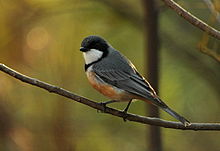
Fantails are small insectivorous songbirds of the genus Rhipidura in the family Rhipiduridae, native to Australasia, Southeast Asia and the Indian subcontinent. Most of the species are about 15 to 18 cm long, specialist aerial feeders, and named as "fantails", but the Australian willie wagtail is a little larger, and, though still an expert hunter of insects on the wing, concentrates equally on terrestrial prey.
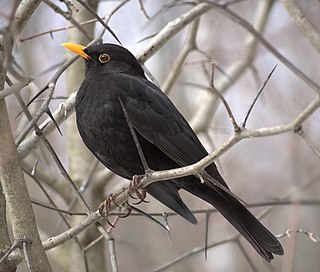
True thrushes are medium-sized mostly insectivorous or omnivorous birds in the genus Turdus of the wider thrush family, Turdidae. The genus name Turdus is Latin for "thrush". The term "thrush" is used for many other birds of the family Turdidae as well as for a number of species belonging to several other families.
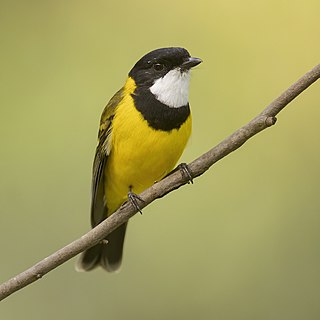
The Australian golden whistler or golden whistler, is a species of bird found in forest, woodland, mallee, mangrove and scrub in Australia. Most populations are resident, but some in south-eastern Australia migrate north during the winter. Its taxonomy is highly complex and remains a matter of dispute, with some authorities including as many as 59 subspecies of the golden whistler, while others treat several of these as separate species.

An aracari or araçari is any of the medium-sized toucans that, together with the saffron toucanet, make up the genus Pteroglossus.

Eopsaltria is a genus of small forest passerines known in Australia as the yellow robins. They belong to the Australasian robin family Petroicidae. The name is derived from the Ancient Greek for "dawn singer/song" because of their dawn chorus. They are inquisitive and bold birds, and have been reported perching on the shoulders or boots of people in the bush. Open eucalyptus woodlands are their preferred habitat. The ornithologist John Gould likened the behaviour and mannerisms of the eastern and western yellow robin to those of the European robin. The name "yellow robin" itself was applied to the eastern yellow robin by the early settlers of New South Wales.
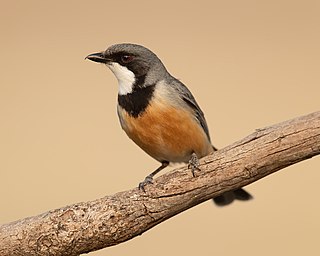
The rufous whistler is a species of whistler found in New Caledonia and Australia. Predominantly a reddish-brown and grey bird, it makes up for its subdued plumage with its song-making ability. Like many other members of the Pachycephalidae, it has a variety of musical calls.
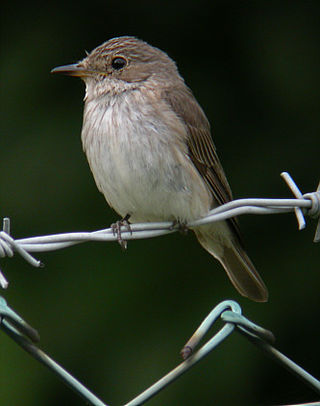
Muscicapa is a genus of passerine birds belonging to the Old World flycatcher family Muscicapidae, and therein to the typical flycatchers of subfamily Muscicapinae. They are widespread across Europe, Africa and Asia with most species occurring in forest and woodland habitats. Several species are migratory, moving south from Europe and northern Asia for the winter.

Criniger is a genus of songbirds in the bulbul family, Pycnonotidae. The species of Criniger are found in western and central Africa.

Hypsipetes is a genus of bulbuls, songbirds in the family Pycnonotidae. Most of its species occur in tropical forests around the Indian Ocean. But while the genus is quite diverse in the Madagascar region at the western end of its range it does not reach the African mainland.
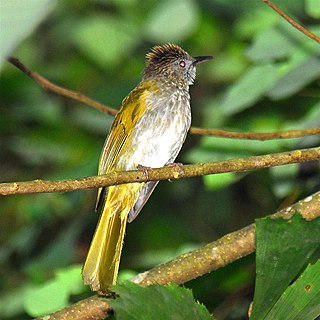
Ixos is a genus of passerine birds in the bulbul family, Pycnonotidae.
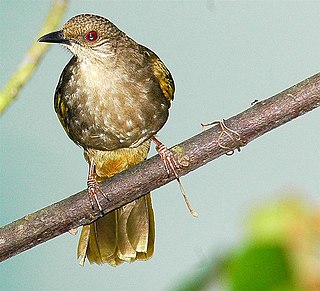
Pycnonotus is a genus of frugivorous passerine birds in the bulbul family Pycnonotidae.

A shrikethrush, also spelled shrike-thrush, is any one of eleven species of songbird that is a member of the genus Colluricincla. They have nondescript, predominantly brown or grey, plumage, but are accomplished singers, their calls described as "strong, mellow and beautiful." Shrikethrushes are generally insectivorous, though have been recorded eating molluscs and berries. They build cup-shaped nests in the forks of trees.

The lovely fairywren, or lovely wren, is a species of bird in the Australasian wren family, Maluridae. It is endemic to northeastern Australia. Its natural habitats are subtropical or tropical dry forest and subtropical or tropical moist lowland forest.
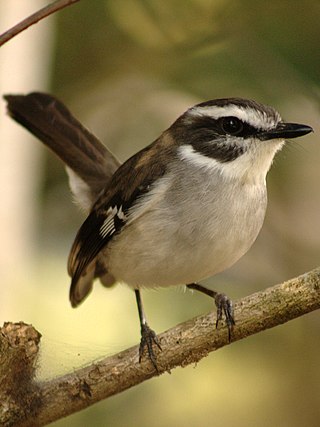
Poecilodryas is a genus of passerine birds in the Australasian robin family Petroicidae.

The bristlebills are a genus Bleda of passerine birds in the bulbul family Pycnonotidae. They are found in the forest understorey of western and central Africa. They forage for insects at or near ground-level, often near water. They will follow driver ant swarms to catch prey items fleeing from the ants and they frequently join mixed-species feeding flocks.
Pseudorectes is a bird genus in the family Pachycephalidae endemic to New Guinea.
The cinnamon-breasted whistler is a species of bird in the family Pachycephalidae. It is endemic to Obira in the Maluku Islands. Formerly, some authorities considered it to be a subspecies of the rufous whistler, while others continue to classify it as a subspecies of the drab whistler.

Pitohui is a genus of birds endemic to New Guinea. The birds formerly lumped together as pitohuis were found by a 2008 study that examined their evolutionary history on the basis of the genetic sequences to have included birds that were quite unrelated to each other. They have since been separated into other genera.
The Baliem whistler or Balim whistler is a species of bird of the whistler family Pachycephalidae that is endemic to New Guinea.

Lalage is a genus of passerine birds belonging to the cuckooshrike family Campephagidae, many of which are commonly known as trillers. There are about 18 species which occur in southern Asia and Australasia with a number of species on Pacific islands. They feed mainly on insects and fruit. They build a neat cup-shaped nest high in a tree.
